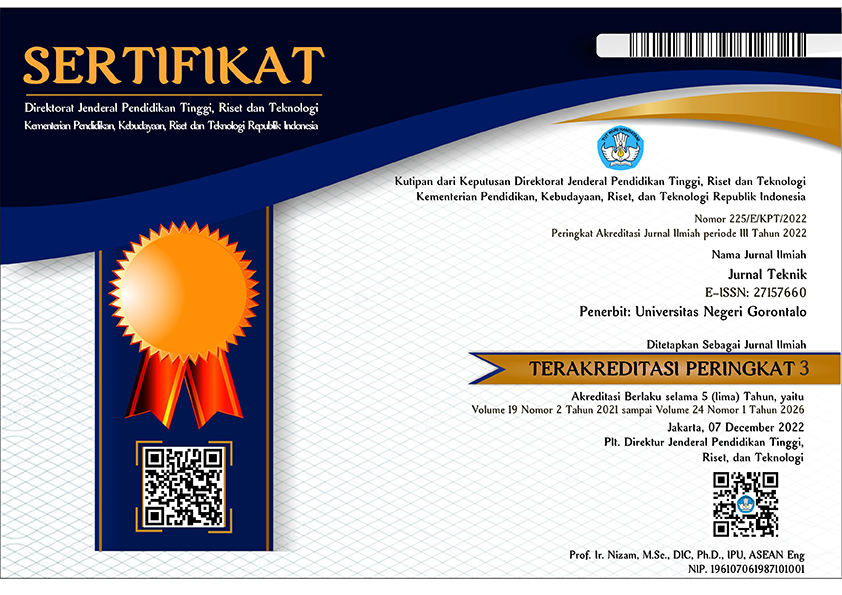Pre-Feasibility Evaluation of the Eco-Cooler Model Made of Waste for Hot Humid Climates
Abstract
Based on the results of a survey conducted by the Ministry of Energy and Mineral Resources in 2018 on commercial buildings, the largest energy-using equipment of each commercial building is air conditioning equipment with an average energy use of over 62%. Therefore, energy-saving efforts related to space cooling will have a significant impact on energy-saving efforts in the world. One way is to use the wind catcher method, namely Eco-Cooler. On the other hand, based on data from the National Waste Management Information System in 2021, waste generation in Indonesia reached 30,881,803.15 tons per year. So this research aims to find the lightest eco-cooler material that can withstand the weather using composite materials from waste. This research uses an experimental method by making an eco-cooler prototype using processed waste materials such as wood powder, corn cobs, plastic, and sand. Then 2 types of sizes, namely the outlet diameter (D1A) of 40 cm, and the inlet diameter (D2A) of 20 cm, while the second size is the outlet diameter (D1B) is 30 cm, and the inlet diameter (D2B) is 15 cm. After molding, the eco-cooler was then weighed and observed for a month to see its resistance to weather where the weather at that time was quite fluctuating. The parameters tested in this study were material weight and weather strength in the humid tropical climate. From the results of this study, it is found that the eco-cooler with sawdust material has the lightest weight of 16 kg for a diameter of 40 cm and 15 kg for a diameter of 30 cm. Meanwhile, the heaviest material is sand with a weight of 29 kg for a diameter of 40 cm and 23 kg for a diameter of 30 cm. In terms of durability, sawdust and sand are the most resistant to weather. Therefore, it can be concluded that the lightest and most weather-resistant eco-cooler material for hot humid climates is eco-cooler from wood powder material.
Downloads
References
Agency for the Assessment and Application of Technology. (2021). OUTLOOK ENERGI INDONESIA 2021 Perspektif Teknologi Energi Indonesia: Tenaga Surya untuk Penyediaan Energi Charging Station.
Bhanuprakash, C., Mummina, V., & Mahesh Chakravarthi, V. (2018). Performance Evaluation of an Eco-Cooler analysed by varying the Physical and flow Parameters. IOP Conference Series: Materials Science and Engineering, 377(1). https://doi.org/10.1088/1757-899X/377/1/012024
Dr. Sugiarto Mulyadi. (2019). SAMPAH MAKANAN atau FOOD WASTE. Pt. Amrita Enviro Energi - Pt. Tirtakreasi Amrita, 1–3.
Hardiputranto, A. R., Kusno Adi Sambowo, & Ririt Aprilin Soekarsono. (2021). Pemanfaatan Abu Limbah Bonggol Jagung Sebagai Bahan Tambah Dengan Variasi Suhu Pembakaran Terhadap Kuat Tekan Beton. Menara: Jurnal Teknik Sipil, 16(2), 67–72. https://doi.org/10.21009/jmenara.v16i2.20112
Hermanto, A. A. S. A. A. D. P. (2005). Pengembangan Metode Simulasi Sistem Pengkondisian Udara Energi Surya. Jurnal Teknik Mesin Volume 20, 20(2).
I Wayan, S. (2016). Pemanfaatan limbah industri pengolahan kayu di kota denpasar (studi kasus pada cv aditya). X(1), 15–22.
Irwan, Sukendar; Afida, H. R. A. K. A. R. F. Y. M. F. A. R. A. R. N. (2016). Rancangan dan Karya Teknologi Pembuatan Batako dari Limbah Serbuk Gergaji ( Dipresentasikan pada UKM Penggergajian Kayu Jurusan Teknik Industri Fakultas Teknologi Industri Universitas Islam Sultan Agung.
Kementerian ESDM. (2018). Benchmarking Specific Energy Consumption Di Bangunan Komersial. www.b2tke.bppt.go.id
Khan, A. H., Ahmed, Z., Islam, M. S., & Ghosh, A. K. (2019). Evaluation of cooling capability of an eco-cooler experimental and numerical analyses. Energy Procedia, 160(2018), 100–107. https://doi.org/10.1016/j.egypro.2019.02.124
Moffit, B. (2013). Composite Materials in Building and Construction Applications. ACMA’s CORROSION, MINING, INFRASTRUCTURE & ARCHITECTURE CONFERENCE, 52.
Mohanad I. Altuma, & Redvan Ghasemlounia. (2021). Effects of Construction Materials to Achieve Sustainable Buildings. International Journal of Engineering and Management Research, 11(1), 25–30. https://doi.org/10.31033/ijemr.11.1.4
Naveenkumar, P., Raguraman, K., S, R. K., & Krishnaraj, M. (2018). Design and Analysis of Eco Cooler. 4(2), 384–390.
Phillipson, M. C., Emmanuel, R., & Baker, P. H. (2016). The durability of building materials under a changing climate. Wiley Interdisciplinary Reviews: Climate Change, 7(4), 590–599. https://doi.org/10.1002/wcc.398
Pratiwi, N., & Arifin, S. S. (2021). Analisis Performa Model Eco-Cooler Sebagai Alternatif Bukaan Alami. Nature: National Academic Journal of Architecture, 8(1), 1. https://doi.org/10.24252/nature.v8i1a1
Siradjuddin Haluti. (2014). Mapping the potential of corn cob waste as an alternative energy in Gorontalo Province region. https://repository.its.ac.id/48728/
Sistem Informasi Pengelolaan Sampah Nasional. (2021). SIPSN - Sistem Informasi Pengelolaan Sampah Nasional. Https://Sipsn.Menlhk.Go.Id/. https://sipsn.menlhk.go.id/sipsn/public/data/timbulan
Sofiana, Y. (2010). Pemanfaatan Limbah Plastik sebagai Alternatif Bahan Pelapis (Upholstery) pada Produk Interior. Humaniora, 1(2), 331. https://doi.org/10.21512/humaniora.v1i2.2874
Tika, I. N., Ayu, I. G., Agustiana, T., Agus, D., & Erawan, W. (2017). Pengolahan Limbah Serbuk Gergaji Kayu Menjadi Bata Akustik. SEMINAR NASIONAL PENGABDIAN KEPADA MASYARAKAT (Senadimas), 585–593. https://docplayer.info/111008304-Pengolahan-limbah-serbuk-gergaji-kayu-menjadi-bata-akustik.html
UNG. (2020). Rencana Strategis Universitas Negeri Gorontalo 2020-2024.
Widharmana. (1973). Logging Waste dan Kemungkinan Pemanfaatannya. Kerjasama Direktorat Jenderal Kehutanan Dan Fakultas Kehutanan IPB. Bogor.
Copyright (c) 2023 Niniek Pratiwi, Ernawati (Author)

This work is licensed under a Creative Commons Attribution-ShareAlike 4.0 International License.













